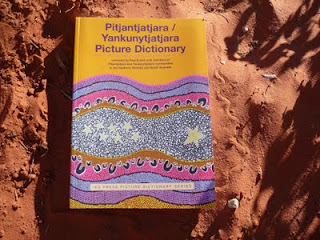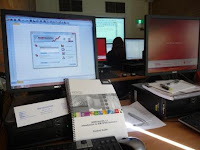Pitjantjatjara and Yankunytjatjara are two similar, but distinct dialects of the Western Desert language group spoken by the Anangu people in the centre of Australia near Uluru-Kata Tjuta.
Pitjantjatjara and Yankunytjatjara have been written using 14 letters from the English alphabet, with some consonants being underlined to indicate that the sound is retroflex (made with the tongue tip back). There are
6 vowels: a, aa, i, ii, u, uu
2 diphthongs: au, ai
17 consonants:
5 stops: p, t, t, tj, k
5 nasals: m, n, n, ny, ng
7 liquids and glides: l, l, ly, w, r, y
1 trill: r (never in word-intial position)
The first syllable of every word is stressed.
Many words are created with the addition of suffixes. For example, karu = creek, kutu = to, therefore karukutu = to the creek.
In the Pitjantjatjara/Yankunytjatjara picture dictionary there are no words listed for hello, thankyou, or yes. There are four different words for go (go away from, go hunting, go in, go past). Here are some words
 |
| Sharynne at Uluru near rock paintings by the Anangu people |
no = wira
talk = wangkanyi, watjani
tongue = tjalinypa
teeth = katiti
Source: Ekert, P. (2007). Pitjantjatjara/Yankunytjatjara picture dictionary. Alice Springs, NT: IAD Press.









